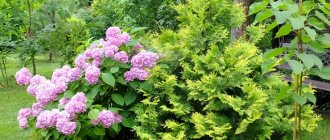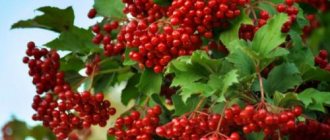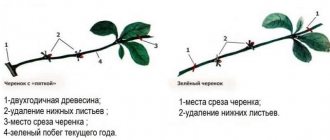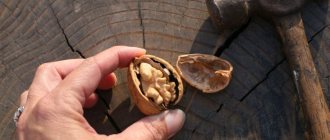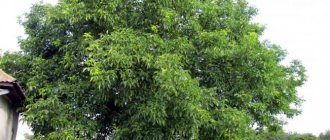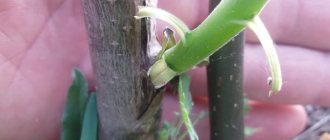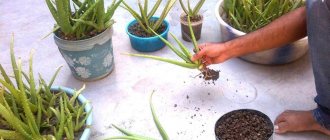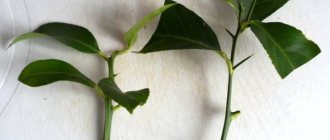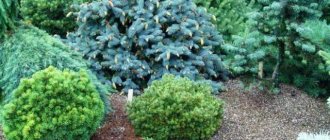Is it possible to grow a crop from a petiole?
Reproduction of walnuts using cuttings is practically no different from propagation of other trees. The walnut develops very slowly. In addition, during seed propagation the tree does not retain its varietal characteristics. Therefore, it is not only possible to vaccinate, but it is also recommended to do so. Thanks to this method, you can grow a high-quality seedling that will begin to bear fruit much earlier.
Nut cuttings have certain nuances:
- The maximum diameter of the stem is 15 mm.
- Only young walnut seedlings are taken for the rootstock. Their age must be no more than three years.
- You can take shoots of the current season, cut from fruit-bearing trees.
- The diameter of the cutting should not exceed 8 mm.
Advice
The scion and rootstock varieties must be well combined. It is necessary that they have the same frost resistance and other important characteristics.
It is recommended to use as a rootstock varieties that take root well in a new location and produce a large harvest. These include:
- Five-year plan.
- Fruitful.
- Dawn of the East.
For grafting, you can take cuttings of Hinja and rock nut. But these varieties do not tolerate winter very well, although they are resistant to various diseases.
Advice from experienced gardeners
You shouldn’t rush to uproot a walnut if you don’t like the variety or the tree dies. Gardeners say that it can be saved by grafting. It is enough to master the skills of budding.
Walnut grafting is a good solution for residents of the Northern and Central regions of the country. You can graft your favorite southern shoot onto any frost-resistant tree variety, which will take root well and bear fruit.
For grafting to be successful, the seedling must be planted in the right place. After which, take good care of it for 2 years, and only then use it as a rootstock.
Advice! You need to choose a rootstock and scion for grafting of the same age. So, tissue fusion will be successful. In older trees the processes slow down.
Advantages and disadvantages of cuttings
The main advantages of propagating nuts using cuttings:
- The first harvest can be expected in 3-4 years. When propagated by seeds, flowering occurs in 8-10 years.
- The characteristics of the variety are preserved.
- Rapid plant development.
- Crossbreeding can be controlled.
The disadvantages usually include the following:
- The procedure is more complicated for beginner gardeners.
- About 90% of grafted branches do not survive the first winter.
How to choose a nut for planting
Choosing the right seed for planting is the key to successful cultivation. When purchasing planting material, you need to remember a few rules:
- The best months for choosing fruits are September or early October, when they are already ripe, but have not yet been dried or heat-treated.
- The nut must be large, fully ripe and have a thin shell without visible damage or stains.
- Preference should be given to nuts collected independently or purchased from familiar gardeners. Store-bought nuts may not be fresh, which means their germination rate will be significantly lower than expected.
- For planting, you should choose fruits of those varieties that are suitable for the climatic conditions of your region.
When and how to prepare shoots?
First, shoots are prepared:
- Healthy and annual branches are cut out. Their length should be 35-40 cm, and their thickness should be up to 1.5 cm.
- Cuttings are cut from the branches. Their length should be 15 cm.
The procedure must be performed in early autumn. At home, cuttings from branches are placed in damp sand and left for storage in a dark place. The temperature should be from 0 to +5 degrees. In winter, shoots sometimes need to be inspected. If there is insufficient humidity, the sand becomes slightly wet.
Other ways to propagate walnuts
In addition to cuttings, there are several other ways to propagate walnuts. Each of them has its own characteristics and requires a special approach.
Propagation by seeds
It is better to use nuts from your own harvest as seedlings . You need to select only the largest fruits that are not damaged. Pre-soaking will help prepare the material for planting. To do this, the seedlings are left in water for three days. During this period, the water is changed every day to get rid of the tannins released by the shells.
Did you know? The nutritional properties of walnuts exceed those of potatoes by 7 times.
Then you need to fill the container with moist soil and make small holes about 10 cm deep. Place the seeds edge-wise into these holes. Sprinkle a small layer of sand on top. Finally, you need to cover the container with film. After 10 days, the planted seed will produce its first shoots . Sprouted sprouts can be stored at home for further growth before planting in open ground.
How to prepare a tree?
Attention!
Throughout the season, before cuttings, you need to monitor the soil moisture level. Do not make the soil waterlogged. One watering per week will be enough.
also advisable to fertilize once . For this, organic or mineral fertilizers are used. Organic includes:
- Compost – decomposed branches, leaves, tops, etc.
- Manure.
- Humus is rotted manure.
- Wood ash.
Organic fertilizers are applied in an amount of 3 kg per 1 sq. m. They significantly improve the quality of the soil.
You cannot use organic and mineral fertilizers at the same time. The best solution is to alternate.
If we talk about mineral fertilizers, the nut needs the following elements:
- Manganese.
- Magnesium.
- Zinc.
- Bor.
Manganese and zinc sulfate need only 2.5 g per 1 square meter. m.
Important!
Nitrogen fertilizers cannot be used during the fruiting period.
Before cutting the cuttings, the tree needs to be well watered for several days. Also, throughout the week you should loosen the soil around the trunk.
Care after vaccination
After grafting, walnut seedlings need careful care. After the bandage is removed, the vaccination site is checked. It should be dry. If several cuttings were used as a scion, then it’s time to choose the strongest and most developed of them. It is left for further growth, the rest are shortened. They are cut out after the tree has taken root well. Experienced gardeners recommend leaving the strongest shoot that grows from the lower bud, which is closer to the graft.
Over the next 3-4 years, the tree crown is formed. All thickening shoots are cut out, which speeds up the formation of fruit buds. In addition, during this period the tree needs more moisture. The soil is maintained in the required condition and freed from weeds. Moisten the area around the tree trunk to a depth of 50-60 cm. Watered mainly in summer. In autumn, the soil is not moistened, otherwise the growth of grafted seedlings is hampered and their winter hardiness is reduced.
Fertilizers have a greater effect on the growth of walnuts. After grafting, seedlings need nitrogen, phosphorus and potassium supplements. Add them according to the instructions:
- At the beginning of summer, dry nitrogen mixtures are distributed around the tree trunk. For 1 sq. m consume 20-25 g of fertilizer.
- In the fall, 130 g of superphosphate and 35 g of potassium chloride are added to the digging. This is the norm for 1 sq. m for a tree up to 10 years old.
As the tree ages, the amount of fertilizing is increased by 20 g. During the dry period, all fertilizers are applied in liquid form, while in rainy weather it is better to switch to granules.
How quickly a walnut will develop after grafting depends on the condition of its leaves. Therefore, the gardener should pay special attention to the fight against diseases and pests. The tree's leaves must be healthy. For young seedlings during this period, chemicals are contraindicated. It is better to use traditional methods of prevention and prepare an infusion for diseases yourself:
- In a 3 liter container, pour onion peels, chopped garlic, 2 tbsp. tobacco The mixture should occupy 1/3 of the volume of the bottle.
- Fill the container with boiling water and leave for 7-10 days in a dark place.
- Strain the prepared solution. Before spraying trees, dilute 10 liters of water.
This infusion is used in early spring, in the closed bud phase and along the “green cone”.
The following method will help you cope with pests after walnut grafting:
- Pour 500 g of yarrow herb and the same amount of wormwood into a 5 liter bottle.
- Fill the container with boiling water and leave to steep for 2 days.
- Drain the infusion, boil for 30 minutes, cool and dilute with 10 liters of water.
The mixture helps get rid of codling moths, aphids, mites, caterpillars and other pests. Spraying is repeated every 10 days.
How to propagate using different methods?
There are two main methods of propagating walnuts using cuttings. The first is produced in summer, the second in winter. Also sometimes they resort to such a method as splitting. To perform grafting you need a minimum of tools . Required:
- pruner;
- sharp thin knife;
- elastic film or tape.
Budding (propagation by green shoots)
In this propagation method, a healthy bud of the scion is grafted onto the rootstock. The scion is a cutting. The rootstock is the plant to which the growth is carried out. Budding is performed in summer , when the average air temperature is +25°C.
This method is the easiest for propagating walnuts. It is also highly efficient.
The process works as follows:
- Young branches growing on the south side of the tree are selected. Using a sharp knife, a small section of bark is cut off along with the cutting. The same piece of bark is cut from the rootstock.
- The cutting is cleaned and attached in the place where the bark was cut from the rootstock. Using a film, the bud is secured so that only the eye remains open.
- Now you need to provide proper care for the seedling. The film weakens a little if the cutting begins to turn green. After three months it is completely removed.
This is how gardeners receive walnut seedlings obtained by budding.
Advice
The buds of the selected cuttings should have eyes. This increases the chances of survival.
We invite you to watch a video about cuttings using the budding method:
Copulation
For copulation, a young tree (2-3 years) is used. In February, walnut cuttings prepared in advance are brought into a warm place for several days. It is necessary to keep the room temperature at approximately +15°C. Next, the algorithm of actions is as follows:
- A solution of "Epin" is prepared. The cuttings are placed in it for half an hour.
- The lower ends of the scion are cut obliquely. It is necessary that the kidney is located at the opposite end.
- At a distance of 15 mm from the cut, the bark is cut to form a tongue. The same is done on the rootstock.
- The rootstock and scion are connected so that the tongues fit into one another.
- The grafting site is tightly fixed with film or twine.
We invite you to watch a video about cuttings using the copulation method using a stimulator:
Into the cleft
When the diameter of the scion is larger than that of the rootstock, the cleft grafting procedure is performed. To do this, the upper part of the scion is cut obliquely and trimmed into a wedge at the base. After this, the rootstock is split at the top and the scion is inserted into the crack.
This method is suitable when the diameters are not equal. If the difference in size is large, then the crack should be made at the top of the rootstock. The scion should retain the bark on the extreme side. This way both parts will grow together evenly.
Attention!
Cleft grafting is done quickly. It is impossible for the rootstock to oxidize.
We invite you to watch a video about cuttings using the “split” method:
Love at first sight
Walnut trees that produce female flowers first (the so-called protogynous forms) begin and complete shoot formation earlier. Growth processes in shoots are earlier replaced by lignification. Such trees have dark green, smooth shoots, with powerful tops, a waxy silvery coating, rounded lateral buds and short internodes.
For specimens in which male inflorescences bloom earlier than female ones (they are called protoandric), on the contrary, shoots with an elongated, thinned light green tip and a matte ribbed surface of the bark are characteristic. And when male flower buds appear, determining the sex of the seedling at the time of transplantation before flowering begins is not at all difficult.
If they are light, large [5-8 mm], conical, pointed in shape, most of them are located at right angles to the shoot, sometimes in groups (several buds nearby) - the tree is male, first blooms with staminate flowers. If the male flower buds on the seedling are thin or small (2-3 mm), drop-shaped, dark, almost black in color in autumn and spring [sometimes hidden under the covering scales], have a finely faceted surface and are located at an acute angle to the shoot - the tree is protogynous, on It is here that the female pistillate flowers ripen first.
In industrial plantings, 4-6 rows of walnut varieties with initial female flowers are alternated with 1-2 rows of varieties in which male catkins bloom first or simultaneously with the female ones; Self-fertile forms of the nut, which are able to be pollinated by their own pollen or cross-pollinate each other, are planted in even stripes. If a walnut tree is not able, for one reason or another, to be fertilized by its own pollen, and there is no tree nearby whose pollen could fertilize it, it does not bear fruit.
Read also: How to dilute aloe for nose drops
There is another common reason why gardeners may not wait for the walnut harvest. The duration of the growing season for different forms and varieties of nuts also varies. Typically, plants with a short growing season are characterized by later flowering and early ripening of fruits. It is the late-flowering walnut trees that produce a harvest every year because they avoid spring frosts. But the forms that bloom early freeze slightly and then work idle all season.
Landing nuances
There are several basic rules for growing a nut. If you do them correctly, the tree will begin to bear fruit at an early stage of ripening.
- The material is planted exclusively in sunny areas, but not on southern slopes. There the earth is warmer better, which means the plants will wake up earlier. This reduces their frost resistance and provokes a large difference in daily temperature fluctuations, so the trees will suffer from heat during the day and cold at night.
- Only growing early ripening walnuts is possible in a small area. Others need to be grown on an area of more than 80m2.
- It should be planted in moist turf or super-sandy soil. Provided the humus content is over 3%.
Walnuts cannot be grown when the soil is waterlogged or compacted. Only loose soil is suitable. It is useful to plant near lupins or oats.
How does this happen at home and on an industrial scale?
To create plantations to produce walnuts on an industrial scale, the grafting method is most often used. There are certain varieties that are capable of industrial propagation by seed without losing the valuable properties of the mother plant.
This allows you to save on labor costs and reduce the cost of the reproduction process. In addition, grafting will allow you to obtain edible fruits faster than with the seed growing method. For cultivation in a small garden plot, the plant is propagated by the usual seed method or grown planting material is purchased from special nurseries.
Collection and storage of fruits
The walnut harvest usually occurs in September. You should choose only fully ripened, loose fruits with cracked shells. Most of them fall to the ground; the rest can be collected by shaking the tree or using an apple picker.
The collected fruits are cleaned of skin and debris and dried first in the fresh air and then in the oven. Dried nuts can be eaten immediately or stored in a dry, well-ventilated area for a year.
I share with you some little tricks of gardeners and gardeners))
Garden
Walnut is an ideal garden crop, all parts of which are used by humans. It does not require expensive chemical treatments or labor-intensive pruning. The fruits do not need to create special conditions and special containers for storage. They last a long time without losing their taste.
Fast-fruiting walnuts are the work of many breeders over many years. They have many advantages over regular ones.
Advantages of fast-fruiting varieties
Trees of these varieties are low (4-6m) with a compact crown, which makes them easier to care for and harvest. The small size of the crown allows trees to be planted more densely (planting pattern 4x6m), and this increases the yield per unit area.
The fruits are medium-sized (weight 6-9g), thin-skinned, easy to split, have a high kernel content. The kernels are covered with light skin and have a wonderful taste.
Such plants enter the commercial fruiting period twice as early as typical tall walnut trees.
Soil for planting
Walnuts grow best in river backwaters, on alluvial, loose, fertile, light soils. It responds positively to watering, especially in southern arid zones. Compared to other types of nuts, walnuts are the most drought-resistant and heat-resistant species and can withstand prolonged drought.
The best for it are soils with an alkaline (pH > and weakly alkaline (pH)
and weakly alkaline (pH) reaction of the soil solution. It also grows well on soils with a neutral reaction (pH 7). On strongly acidic soils (pH 5 or less) it feels very bad. It has long been noted that The most productive and resilient walnut trees are found on soils enriched with lime.
reaction of the soil solution. It also grows well on soils with a neutral reaction (pH 7). On strongly acidic soils (pH 5 or less) it feels very bad. It has long been noted that The most productive and resilient walnut trees are found on soils enriched with lime.
Features of flowering
Walnut is a monoecious but dioecious plant, i.e. On one tree there are separate male and separate female flowers. Individuals are found predominantly with male flowers, others with female flowers, and still others have approximately the same number of male and female flowers.
In most cases, male and female flowers bloom at the same time on the same tree. Therefore, the nut is adapted to cross-pollination, which is carried out mainly with the help of the wind and is ensured by the simultaneous flowering of female and male flowers on different trees.
For planting, plant genotypes are selected in which the maturation of male catkins coincides with the flowering of female flowers. This ensures a high yield. The selected trees are planted nearby, but not necessarily in their own garden, because
Pollen is carried by the wind over considerable distances.
On large areas, walnuts are planted according to the following scheme: 4-6 rows of varieties with the initial flowering of female flowers are alternated with 1-2 rows of varieties, where male catkins bloom first, but at the same time as the female flowers.
The difference in the flowering time of female and male flowers reaches 9-15 days. In this regard, there are self-fertile varieties and forms in which flowers of different sexes (male and female) on the same tree bloom simultaneously and self-pollinate. Self-fertilizing forms of the nut, which are pollinated by their own pollen or cross-pollinate each other, are planted in even stripes.
The ovary also occurs without pollination, the so-called apomixis. Thanks to it, seedlings inherit all the features of the mother tree.
First male and first female walnut trees
If catkins bloom on a tree first, which release pollen when ripe and fall off, and when they fade, female flowers begin to bloom, then such trees are male (protoandric).
When queen flowers bloom on a tree first, and then staminate flowers (catkins), then these trees are female (protogynous).
The blooming of different flowers on the same tree lasts an average of a week.
Male and female trees are easily and reliably distinguished and selected during flowering, but most fast-fruiting seedlings bloom with male flowers from the age of 4.
Some external signs determine the sex of the seedling even before flowering begins. Female trees begin and complete shoot formation earlier. Growth processes are earlier replaced by lignification.
The tips of their shoots are thick, dark green, smooth, with a waxy silver coating, rounded lateral buds and short internodes.
Male specimens are distinguished by an elongated, thinned light green tip of the shoots, with a matte ribbed surface of the bark.
When male flower buds appear, the sex of the tree is determined very easily. If the male flower buds on the seedling are large (5-8 mm), conical, pointed in shape, most of them sit at right angles to the stem, sometimes several together, light in color - the tree is protoandric (male ).
If the male flower buds on the seedling are thin or small (2-3mm), like balls, dark, almost black in color in autumn and spring, sometimes hidden in integumentary scales, have a small faceted surface and drop-shaped shape, sit at an acute angle to the stem - the tree is protogynous (female).
Features of fruiting
Fruiting at the age of two is the exception rather than the rule, although it does happen. It all depends on which buds (female or male) the seedling has in the first years.
Seedlings of fast-fruiting nuts form only female flowers in the 2nd year, and male inflorescences appear in them in the 4th year.
Therefore, in the absence of other varieties of pollinators, fast-fruiting seedlings can only produce an apomixis harvest.
They often produce a harvest after repeated summer flowering. In summer, the fast-fruiting walnut blooms with racemose inflorescences of summer flowering: both female, male and mixed. Therefore, summer flowering is self-fertilizing. The fruits obtained from repeated summer flowering, when propagated by seed, completely repeat the maternal qualities of the plant.
Reproduction method
Walnuts are propagated by seeds, because its grafting is less successful than that of other fruit trees: dense rootstock is formed, and sap flow through the grafting site is impaired.
During seed propagation, future plants adapt to environmental conditions from the first days of their existence. In adulthood, such trees are quite hardy and resistant to weather surprises, they are the most drought-resistant, and they get sick less. Even from severely frostbitten and cut seedling trees, a new walnut tree can be formed due to the basal shoots.
This method of reproduction is most suitable for northern regions. There are seedlings that are superior in quality to their own parents.
Sprouting nuts is a rather labor-intensive operation, so if there is a lack of time, they do it a little differently. In the fall, walnut seeds are sown directly into the soil, or in the fall they are mixed with wet sand and placed in a cold basement until spring sowing.
Shortening the main root
In the first year of life, all the developmental force of a nut seedling is directed mainly at the tap root, which is many times longer and thicker than the stem. Therefore, if the soil is fertile and light, the taproot of an annual seedling penetrates to a depth of 2 m or more.
But no matter how powerful the taproot system is, when the main root is shortened, its branching increases significantly due to the formation of new lateral roots. Growing small roots make better use of soil nutrient reserves and water, because They are the ones that feed the plant.
Therefore, when sowing sprouted seeds, pinch off the main root.
If ungerminated seeds are sown in autumn or spring, then after germination, picking is necessary, shortening the tap root by 1/3-1/2. You can trim the root of seedlings in the soil with special knives.
Pruning is performed only in cloudy weather, when the seedlings have 2-3 leaves. Then the soil is compacted and watered.
For seedlings for sale, the taproot is cut off while still in the nursery, so when planting them, a stone is not placed under the root.
Nut storage
After harvesting, the nuts are peeled from the shell, if it has not completely fallen off, and dried in the sun. Store in a well-ventilated, cool and dry place, spread out in a thin layer. The optimal storage temperature is 0-3°C.
To ensure that nuts are stored for a long time and do not lose their taste and nutritional properties, they are processed.
The collected nuts without a green shell are lightly dried and immersed in salted boiling water (150 g of table salt per 10 liters of water). Immediately remove the pan from the heat and soak the nuts in this solution for 8-10 hours.
After this, they are dried well on all sides in the open air. It is best to do this in sunny weather in a draft.
Well-dried nuts can be stored for more than 2 years without losing their taste and freshness. Just don’t store them in a warm place, because nut kernels contain a lot of fats, which at room temperature quickly age and begin to taste bitter.
Source: https://sovetik.in.ua/oreh-vyrashhivanie/
Seeds
To grow a beautiful, well-bearing tree, you need to take large, fully ripened fruits without any damage to the shell. It is better to buy healthy kernels in small stands with fresh vegetables than in large retail chains or hypermarkets. It is correct to start sowing in spring or autumn. Germination time often depends on both the planting period and the shelf life of the nut. Reproduction by seeds makes it possible to grow another female tree that will grow quickly and bear fruit well.
Spring planting
Before starting the main stage of reproduction in the spring, good walnut seedlings are kept in water for three days. The seeds need to be kept in any growth stimulant for the same amount of time. In this case, the water and growth-stimulating solution is changed every day. This will relieve the future sprout of the high content of essential substances contained in the shell. After this time, soil is poured into the growing container, moistened and the nut is placed on its side. The fruit is deepened by 6-8 cm, covered with sand on top (the thickness of the layer is no more than a finger) and covered with a layer of polyethylene. “Artificial” cultivation of seeds in the spring gives the first shoots after 10 days from the moment of planting. If the kernel for propagation was purchased in the fall or winter, it should be properly stored until the beginning of April. You need to put it in damp sand and put it in a cool place. At the beginning of March, the nut is transferred to another container and the propagation process begins by soaking in a growth stimulator.
Autumn sowing of walnut seeds
The autumn stage of reproduction differs in the way the fruit germinates. The seeds are buried in holes prepared in advance on the site with soil, which is loosened and cleared of roots. The sowing depth is approximately 10 cm. Future sprouts are watered from above and left to germinate until spring. During germination, weak individuals are removed, and strong ones continue to be grown and wait for the harvest already in the 6th year of growth. It is believed that during the winter the kernels go through a stage of stratification. And seedlings expressed in this way are more stable and strong.

